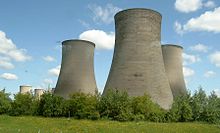History and Development of Cooling Towers
– Cooling towers originated in the 19th century with the development of condensers for steam engines.
– Condensers reduce back pressure and fuel consumption by using cool water to condense steam.
– Limited water supply posed a challenge for land-based systems.
– Evaporative methods of recycling cooling water were used in areas without established water supply.
– Early cooling towers were positioned on rooftops or as free-standing structures.
Types of Cooling Towers
– Cooling towers can be classified as natural draft or induced draft.
– Natural draft cooling towers rely on natural airflow for air induction.
– Induced draft cooling towers use fans to induce air flow.
– Cooling towers can also be classified as evaporative or dry cooling towers.
– Evaporative cooling towers use water evaporation to remove heat, while dry cooling towers rely solely on air.
Applications of Cooling Towers
– Cooling towers are used in oil refineries, chemical plants, power stations, and HVAC systems.
– They are used to cool circulating water and working fluids.
– Cooling towers are essential for steam turbines in power plants.
– They vary in size, from small rooftop units to large hyperboloid structures.
– Hyperboloid cooling towers are commonly associated with nuclear power plants.
Hyperboloid Cooling Towers
– The first hyperboloid reinforced concrete cooling towers were built in the Netherlands in 1918 and later in the United Kingdom in 1924.
– Hyperboloid cooling towers are used in coal-fired power stations and industrial plants.
– They can reach heights of up to 200 meters and diameters of 100 meters.
– Hyperboloid cooling towers are often mistaken for emitting harmful fumes, but they mostly emit water vapor.
Future Developments in Cooling Towers
– The Maisotsenko Cycle (M-Cycle) is a method of reducing fluid temperature below the wet bulb temperature.
– The M-Cycle has potential applications in air conditioning, cooling towers, and other processes involving humid gas streams.
– The consumption of cooling water by processing and power plants is estimated to impact power availability in the future.
– Researchers have developed a method for steam recapture using ion beams and wire mesh.
– The captured steam meets EPA potability standards. Source: https://en.wikipedia.org/wiki/Cooling_tower
A cooling tower is a device that rejects waste heat to the atmosphere through the cooling of a coolant stream, usually a water stream, to a lower temperature. Cooling towers may either use the evaporation of water to remove heat and cool the working fluid to near the wet-bulb air temperature or, in the case of dry cooling towers, rely solely on air to cool the working fluid to near the dry-bulb air temperature using radiators.




Common applications include cooling the circulating water used in oil refineries, petrochemical and other chemical plants, thermal power stations, nuclear power stations and HVAC systems for cooling buildings. The classification is based on the type of air induction into the tower: the main types of cooling towers are natural draft and induced draft cooling towers.
Cooling towers vary in size from small roof-top units to very large hyperboloid structures that can be up to 200 metres (660 ft) tall and 100 metres (330 ft) in diameter, or rectangular structures that can be over 40 metres (130 ft) tall and 80 metres (260 ft) long. Hyperboloid cooling towers are often associated with nuclear power plants, although they are also used in some coal-fired plants and to some extent in some large chemical and other industrial plants. The steam turbine is what necessitates the cooling tower. Although these large towers are very prominent, the vast majority of cooling towers are much smaller, including many units installed on or near buildings to discharge heat from air conditioning. Cooling towers are also often thought to emit smoke or harmful fumes by the general public, when in reality the emissions from those towers mostly do not contribute to carbon footprint, and consist solely of water vapor.
